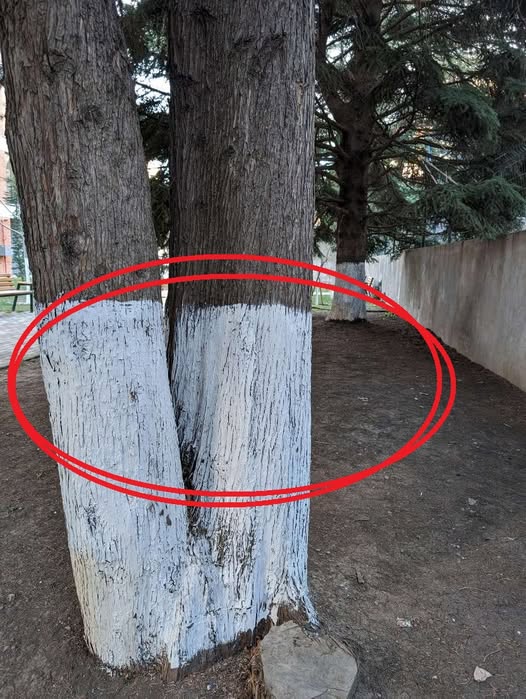Why Are Some Trees Painted White?
I used to wonder why some trees have white-painted trunks. Every time I passed by, I asked myself if it meant something important. Was it a warning? A decoration? Or just an odd tradition? Recently, I discovered that this simple trick carries a very specific and practical purpose—one that protects the tree and even communicates important information to those who care for it.
Tree Markings and What They Mean
It’s not just white paint that tree trunks get. If you pay attention, you might notice trees with orange dots, purple markings, or even red stripes. Each marking is a code. Orange dots often signal that a tree will be cut down in the near future—perhaps because it’s diseased, too old, or blocking construction. Purple marks typically indicate private property or “no trespassing,” alerting passersby or workers that the tree belongs to someone.
White paint, however, serves a completely different role. Unlike these other markings, it’s not about signaling ownership or future plans—it’s about protection. It shields the tree from one of the most common yet overlooked winter threats: sunscald.
How Winter Can Harm Trees
During winter, trees face extreme temperature swings that are far more damaging than most people realize. On sunny days, the bark absorbs sunlight and warms up, causing it to expand. But when night falls, temperatures can drop drastically, making the bark contract quickly. This repeated cycle of expansion and contraction can crack the bark, sometimes deeply enough to expose the inner layers of the tree.
These cracks don’t just look bad—they compromise the tree’s health. In severe cases, they allow insects, fungi, and diseases to enter, weakening the tree and sometimes killing it over time. Young trees and thin-barked species are particularly vulnerable, as they don’t have the same natural protection that older or thicker-barked trees possess.
White Paint as a Natural Sunscreen
This is where white paint comes in. The bright white color reflects sunlight instead of absorbing it, keeping the trunk cooler during the day. By preventing overheating, the paint reduces the expansion and contraction cycles that lead to bark splitting. In effect, it acts like sunscreen for the tree, shielding its delicate trunk from extreme winter conditions.
Some arborists even recommend applying white paint to newly planted saplings, as young trees are especially prone to sunscald. Mature trees aren’t immune either—sun-exposed trunks or thin-barked species can still benefit from this protective layer.
How to Apply White Paint to Trees
Tree planters usually use water-based latex paint for this job, because it’s safe for the tree and doesn’t interfere with the trunk’s natural growth. Proper dilution is crucial: a mixture of one gallon of paint with one gallon of water creates a thin, even coat that spreads easily. Too thick, and the paint can trap moisture, which could invite mold or fungi; too thin, and it won’t reflect enough sunlight to protect the bark.
Application is straightforward. A brush works well for smaller trees, while a spray system is often used for larger areas. The goal is to cover the trunk from the base up to the first branches, or at least as far as the sun’s rays are likely to hit. Careful coverage ensures that the tree is fully protected from sunscald during the harsh months.
How Often Should You Repaint?
White paint doesn’t last forever. Most experts recommend reapplying it once a year, ideally in late fall before the most extreme winter temperatures arrive. A single coat can provide ongoing protection throughout the cold season, helping the tree survive and thrive even in harsh climates.
A Small Gesture with Big Impact
What struck me most about learning the reason behind white-painted trees is how simple yet effective it is. Something as unassuming as a coat of paint can dramatically improve a tree’s chance of surviving winter damage. It’s a reminder that even small, thoughtful actions can have lasting consequences.
The next time you walk past a tree with a bright white trunk, pause for a moment and appreciate it. That color isn’t just for looks or for tradition—it’s a protective measure, a small but meaningful gesture that keeps our leafy friends safe and healthy year after year.
Beyond Protection: A Lesson in Care
White paint also reflects a deeper philosophy in tree care: attention to the details that many overlook. Just as gardeners water plants, prune branches, and check soil health, painting tree trunks is part of a long-term commitment to their well-being. It’s a quiet act of stewardship, one that quietly communicates, “I am protecting you.”
By learning about these practices, we can see trees not as passive scenery, but as living organisms that rely on human attention to survive in urban and rural environments alike. The simple white paint reminds us that care doesn’t always have to be complicated—sometimes, the smallest, simplest gestures make the biggest difference.
Next time you see a row of trees with white trunks lining a street, a park, or a farm, remember the purpose behind it. Each tree has been tended to, protected, and prepared for winter’s challenges. And in that small act of painting, there’s a story of foresight, care, and respect for the natural world—a story written in white.
